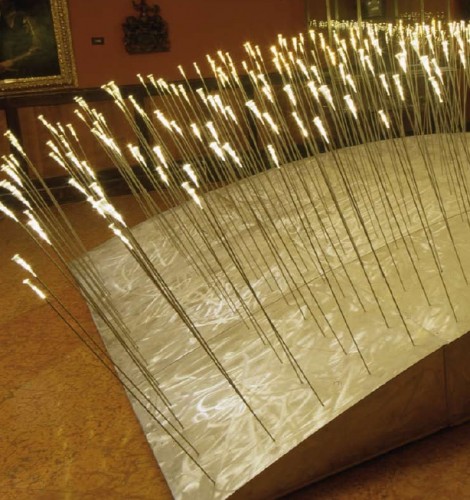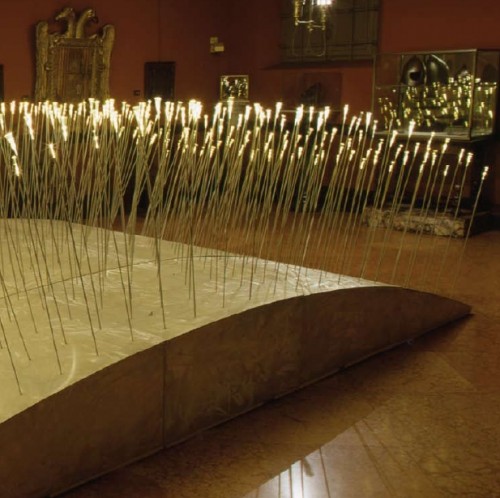Gianna Maria Gatti:
(translated from the Italian by Alan N. Shapiro)
The digital images of flowers, fields, and gardens created by Pietro Mussini at the computer do not constitute the work in itself, but rather a moment of passage, useful for re-elaborating nature according to different solutions, studying forms and expressive combinations of nature’s sounds and colors, constructing graphically that which will be concretized in sculpture.
In the possibilities offered to him by the computer, Mussini has found the ideal media to interpret and develop his idea of nature. It is a media capable of gathering together and enhancing the value of those suggestions and lessons matured starting from childhood and pursued in his artistic research, aimed at combining nature and geometry. The artist himself, re-evoking either the races which, as child, he ran in the fields, discovering their colors and smells, or the successive scholastic lessons oriented to the study of numbers and figures, asserts: “I believe that these two things (the field and the line) have been fundamental and I found them again in all of my work, in so a determining way as to guide my attitude. On the one hand, the conceptuality of lines, of the fractional, on the other hand, the reference to primary nature, to history. Nature and history continuously interrupted by the number, by speed, by fractionals which in their turn recompose possible natures, memories of this.”
It is on the computer that is born in 1986 Planimetria di una messe (Planimetry of a Harvest), an artificial wheat field where each ear becomes a module that is serially repeatable to infinity thanks to digital technologies “which materialize in sculpture the sign ‘ear of wheat’ and consign it to memory.” This field that is virtually planned and elaborated on the computer is thought by the artist as a concrete sculpture that, taking form in physical reality, can enter into contact with it. The important planning phase that distinguishes each work created by Mussini finds fulfillment in the plastic, material construction since the artist’s intent is not to create a work visible only on the computer, but rather to render tangible and usable the obtained effects, to make its ‘computerized’ nature interact with a real environment. Planimetra di una messe (Planimetry of a Harvest) develops an interactive component: in each element-ear is foreseen the insertion of luminous LEDs (Light Emitting Diodes) sensitive to the passage of visitors and to external stimuli such as air and temperature. The LEDs can react or light up or else, passing from an illumination of yellow color to a red one, transform themselves symbolically from ears into poppies. The first sculptural realization of this project is Senza petali (Without Petals) of 1987: a single LED flower of iridescent hue, supported by a steel rod and activated by a microprocessor enclosed in a compact pedestal. But it is with Come un soffio di vento (Like a Breath of Wind) of 1994 that Planimetra di una messe (Planimetry of a Harvest) takes form. Its realization occurs in response to the invitation of Ernesto Francalanci to participate in the “Oltre la scultura” (“Beyond Sculpture”) exhibit organized by him, in a special and more experimental section dedicated to the new forms of art and communication oriented toward the employment of electronic technologies, part of the “Sedicesima Biennale Internazionale del Bronzetto” (“Sixteenth International Biennale of the Small Bronze”) of Padova of 1995.
The dense succession of exiled metallic stems terminating with LED filaments of variegated tonalities of yellow is a reminiscence of a real wheat field moved by the wind, but at the same time reveals its technological nature. On the contrary, it shows itself in all of its artificiality, in a structure of the forms of an essential purity that contains – while concealing them – microprocessors and electronic circuits necessary to the functioning of the installation. A broad metal base, as solid grounding, raises itself from the soil, making a soft curve that confers on it a semblance of naturalness: in accordance with it, the arrangement of the steel ears that are inserted into it lowers to various heights, livening up the perceptual ensemble of luminous glows. It is the fluid and soft light of the LED that reheats, that restores lightness and at the same time vitality to the cold voluminous installation, as well as involving with its faint reverberations the context in which the work is inserted.
It is therefore ears of fiber optic that Mussini makes grow in his artificial field; he creates a nature that, starting from the memory of real nature, develops itself utilizing the same materials and codes of electronic technology with which man is by now used to cohabiting and communicating. For the artist, machines become mediators of artistic action whereas “the computer, subject/object of a reciprocal exchange among several natures, of an osmosis among artifices, in a combinatorial game of poetics, metaphors and sensorial solutions that combine light, sound and color, becomes the possible tool of a contemporary making of poetry.”
To scan the movement of this technological nature, that which Marcello Pecchioli defines as “diffracted, fast, binary, indissoluble time,” time governed by electronics and informatics; Mussini’s modules “are capable of evoking once again that slightly feverish excitation that is created in contact with technology, that petulance which technological devices carry in themselves… Mussini succeeds in transforming all that into a vital, poetic charge, bending the electronic modularity of chromatic and acoustic tasks that his devices, machines and boxes carry out with skill and with splendid esprit de corps, as in a sort of very tight-knit electronic college, and bringing to the surface that poetic vehemence that we will have never suspected of being able to see at work in electronic objects.” In this original portrait of Pecchioli, the solid group of ears of Come un soffio di vento (Like a Breath of Wind) is well represented, but the interpretation anticipates the effects found in the more well-developed project of 1995, Giardino cablato (Cabled Garden).
Come un soffio di vento, 1995
alluminio, fibre ottiche_size 8
cm 300 x 500 x 150
Come un soffio di vento (Like a Breath of Wind) is in fact only one of the parts that compose the Giardino (Garden), a zone already sown – created – by a ‘terrain’ between the natural and the artificial that little by little, as Mussini cultivates and enriches it with new components, becomes the ideal place for the suggestive scenography of intervention, participation and dance performance. A work-in-progress garden in which flows the entire artistic-creative productive journey carried forward over the years by Mussini and not yet completed. The project of the garden is organized in ten thematic areas dedicated to the different experiences which the user can live through there, elaborated in an original way making use of multiple electronic devices. A world in itself into which one enters slowly “in order to avoid dragging in the speed of our movement a little of the light that is outside, a little of that primary nature”; a world that opens up to visitors in an interactive journey aimed at the discovery of a new relationship with the objects that compose it. The same elements, the same reasons developed by either the architectural-landscapist or the literary cultural tradition on the subject of gardens, like paths, the pond, the fountain, the blooming bed, the bridge, are reshaped in Mussini’s project in an incessant game of polysensorial exchanges. It is a labyrinth of the senses, dense with stimuli where an imaginary fountain made of mirrors and interactive LED displays emanates jets of laser light, where the flower petals become sonorous and, at a touch, emit sounds and sonnets while the fiber optic stems mutate according to perpetual chromatic variations. The path proceeds towards the pond of silent decorations, to admire there the artificial red minnows as much silent as, precisely, ornamental, crossing the area of the environmental simulators and of holographs: a passage that triggers artificial emulators of scents and aromas that produce thermal changes, in a constant climate of simultaneous perceptions and requests underlined by the variegated profusion of sounds and colors: “This way of offering the event-objects to the user-agent of the garden represents the suggestion of a relationship of sociality, of a relationship that is intercultural, almost the verbalization of a friendly look between man and machine as the possible imaginary in telematic civilizations.”
Come un soffio di vento, 1995
alluminio, fibre ottiche_size 8
cm 300 x 500 x 150
To enter into Mussini’s garden is to interact with the sculptures of sound and light that ‘grow’ there, making it possible to broaden one’s one vision and one’s own knowledge of technology; making it possible to relive all that which surrounds us, whether natural or artificial, according to a sensibility constructed on the search for new affinities and communions.
The intercultural relationship, which is the goal of the works of Mussini, in reality permeates them from their formative phases, on the level of that inter-disciplinarity which the artist establishes to create them. To intervene in the planning and constructive moments, Mussini, graphic artist and designer, involves specialists from different fields and educational backgrounds: the organization of the team, of technicians, is for him fundamental from the point of view of combining different knowledge, nourishing a profitable encounter. And he makes this very clear: “Surely this is not an individual work, in other words a saturnine and inspired gift, but rather comes from constant analysis and a constant relationship with the collaborators, with the people who belong to different disciplines. The metaphor is the premise to recount this weave of work between me and other worlds.”

